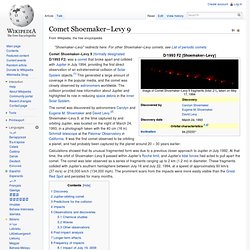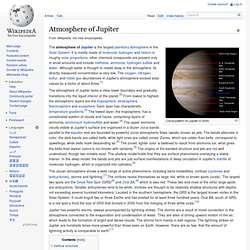

Jupiter. Comet Shoemaker–Levy 9. Comet Shoemaker–Levy 9 (formally designated D/1993 F2) was a comet that broke apart and collided with Jupiter in July 1994, providing the first direct observation of an extraterrestrial collision of Solar System objects.[1] This generated a large amount of coverage in the popular media, and the comet was closely observed by astronomers worldwide.

The collision provided new information about Jupiter and highlighted its role in reducing space debris in the inner Solar System. The comet was discovered by astronomers Carolyn and Eugene M. Shoemaker and David Levy.[2] Shoemaker–Levy 9, at the time captured by and orbiting Jupiter, was located on the night of March 24, 1993, in a photograph taken with the 40 cm (16 in) Schmidt telescope at the Palomar Observatory in California. Atmosphere of Jupiter. Cloud pattern on Jupiter in 2000.

The atmosphere of Jupiter is the largest planetary atmosphere in the Solar System. It is mostly made of molecular hydrogen and helium in roughly solar proportions; other chemical compounds are present only in small amounts and include methane, ammonia, hydrogen sulfide and water. Although water is thought to reside deep in the atmosphere, its directly measured concentration is very low. The oxygen, nitrogen, sulfur, and noble gas abundances in Jupiter's atmosphere exceed solar values by a factor of about three.
Jupiter. Structure Jupiter is composed primarily of gaseous and liquid matter.

It is the largest of four gas giants as well as the largest planet in the Solar System with a diameter of 142,984 km (88,846 mi) at its equator. The density of Jupiter, 1.326 g/cm3, is the second highest of the gas giants, but lower than for any of the four terrestrial planets. Composition Jupiter's upper atmosphere is composed of about 88–92% hydrogen and 8–12% helium by percent volume or fraction of gas molecules.